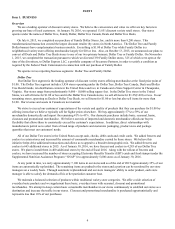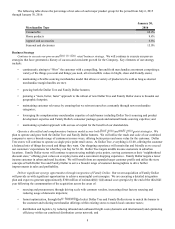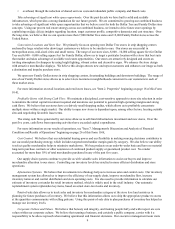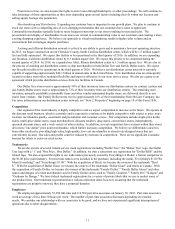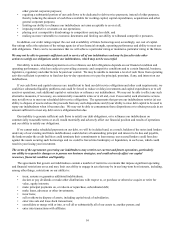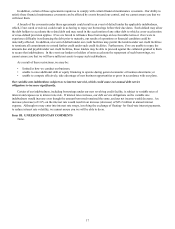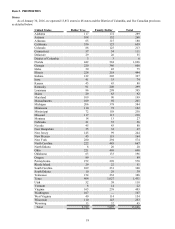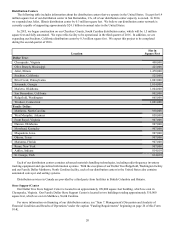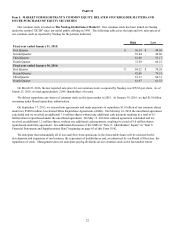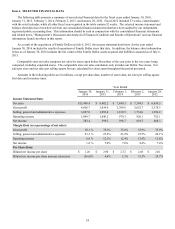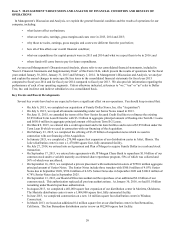Dollar Tree 2015 Annual Report Download - page 32
Download and view the complete annual report
Please find page 32 of the 2015 Dollar Tree annual report below. You can navigate through the pages in the report by either clicking on the pages listed below, or by using the keyword search tool below to find specific information within the annual report.16
other general corporate purposes;
• requiring a substantial portion of our cash flows to be dedicated to debt service payments, instead of other purposes,
thereby reducing the amount of cash flows available for working capital, capital expenditures, acquisitions and other
general corporate purposes;
• limiting our ability to refinance our indebtedness on terms acceptable to us or at all;
• imposing restrictive covenants on our operations;
• placing us at a competitive disadvantage to competitors carrying less debt; and
• making us more vulnerable to economic downturns and limiting our ability to withstand competitive pressures.
In addition, our credit ratings impact the cost and availability of future borrowings and, accordingly, our cost of capital.
Our ratings reflect the opinions of the ratings agencies of our financial strength, operating performance and ability to meet our
debt obligations. There can be no assurance that we will achieve a particular rating or maintain a particular rating in the future.
We may not be able to generate sufficient cash to service all of our indebtedness and may be forced to take other
actions to satisfy our obligations under our indebtedness, which may not be successful.
Our ability to make scheduled payments on or to refinance our debt obligations depends on our financial condition and
operating performance, which are subject to prevailing economic and competitive conditions and to certain financial, business,
legislative, regulatory and other factors beyond our control. We may be unable to maintain a level of cash flows from operating
activities sufficient to permit us to fund our day-to-day operations or to pay the principal, premium, if any, and interest on our
indebtedness.
If our cash flows and capital resources are insufficient to fund our debt service obligations and other cash requirements, we
could face substantial liquidity problems and could be forced to reduce or delay investments and capital expenditures or to sell
assets or operations, seek additional capital or restructure or refinance our indebtedness. We may not be able to effect any such
alternative measures, if necessary, on commercially reasonable terms or at all and, even if successful, such alternative actions
may not allow us to meet our scheduled debt service obligations. The agreements that govern our indebtedness restrict (a) our
ability to dispose of assets and use the proceeds from any such dispositions and (b) our ability to raise debt capital to be used to
repay our indebtedness when it becomes due. We may not be able to consummate those dispositions or to obtain proceeds in an
amount sufficient to meet any debt service obligations then due.
Our inability to generate sufficient cash flows to satisfy our debt obligations, or to refinance our indebtedness on
commercially reasonable terms or at all, would materially and adversely affect our financial position and results of operations
and our ability to satisfy our obligations.
If we cannot make scheduled payments on our debt, we will be in default and, as a result, holders of the notes (and lenders
under any of our existing and future indebtedness) could declare all outstanding principal and interest to be due and payable,
the lenders under the credit facilities could terminate their commitments to loan money, our secured lenders could foreclose
against the assets securing such borrowings and we could be forced into bankruptcy or liquidation, in each case, which could
result in your losing your investment.
The terms of the agreements governing our indebtedness may restrict our current and future operations, particularly
our ability to respond to changes or to pursue our business strategies, and could adversely affect our capital
resources, financial condition and liquidity.
The agreements that govern our indebtedness contain a number of restrictive covenants that impose significant operating
and financial restrictions on us and may limit our ability to engage in acts that may be in our long-term best interests, including,
among other things, restrictions on our ability to:
• incur, assume or guarantee additional indebtedness;
• declare or pay dividends or make other distributions with respect to, or purchase or otherwise acquire or retire for
value, equity interests;
• make principal payments on, or redeem or repurchase, subordinated debt;
• make loans, advances or other investments;
• incur liens;
• sell or otherwise dispose of assets, including capital stock of subsidiaries;
• enter into sale and lease-back transactions;
• consolidate or merge with or into, or sell all or substantially all of our assets to, another person; and
• enter into transactions with affiliates.


